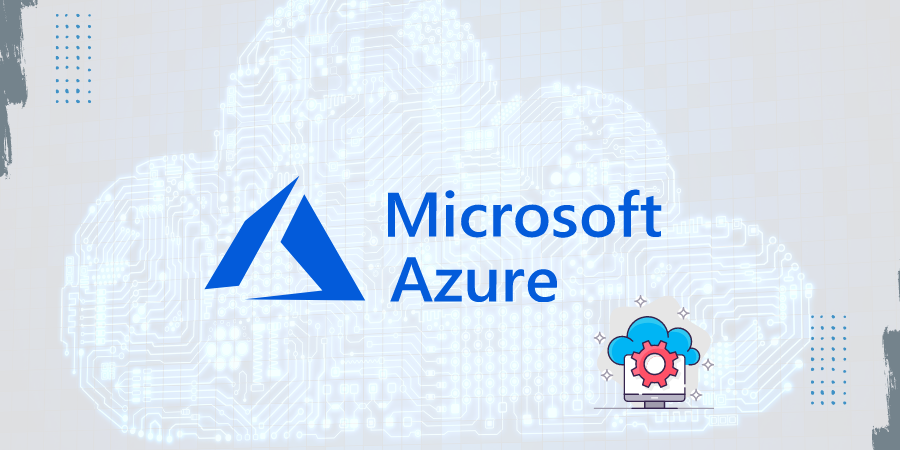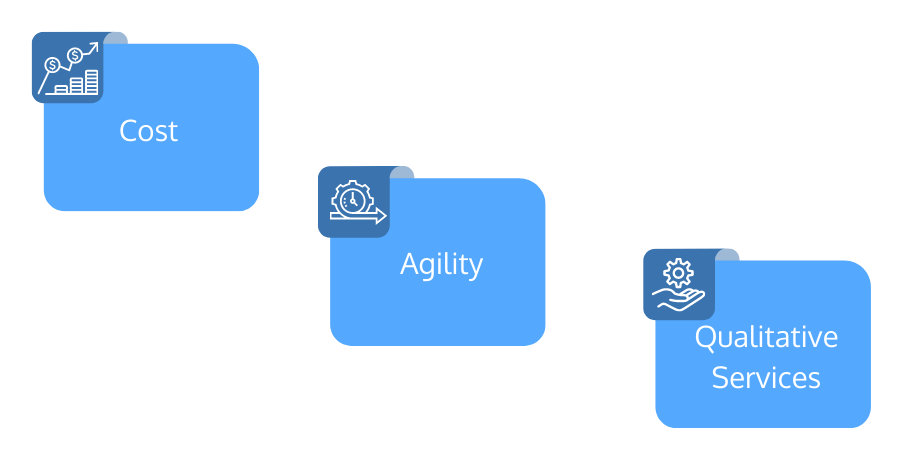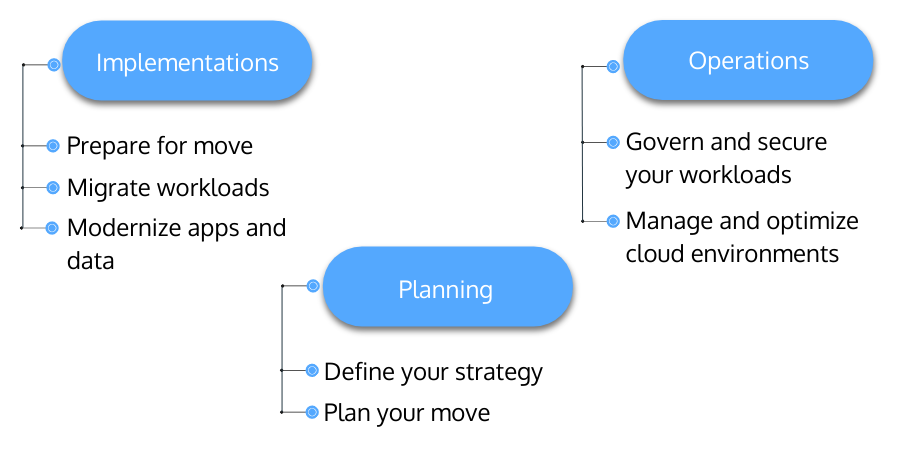
The path to unprecedented advancement follows cloud tools and services to achieve exceptional growth. It allows customers to connect people, data, and processes in effective ways while leveraging opportunities provided by the latest technologies. To thrive in a digital-first environment, industry experts integrate business and IT capabilities and improve operations to provide new value for customers through tailored and packaged software.
Understanding Microsoft Azure
Microsoft Azure is a cloud computing platform offering Infrastructure as a Service (IaaS), Platform as a Service (PaaS), and Software as a Service (SaaS) capabilities for data analytics, virtual computing, storage, networking, and other services. It can be used to supplement or replace on-premise servers.
MS Azure enables developers and IT professionals to design, deploy, and manage applications using several cloud-based tools (services) and frameworks across a global network of data centers.
Azure offers advantages such as speed, flexibility, minimized operational costs, augmented performance, and reliability. In response to cloud adoption barriers, Azure gives hybrid cloud strategies connecting on-premises data centers to the public cloud. In addition, to meet challenges associated with the digital transformation, the Azure platforms can assist in determining how to:
- Optimize operations and resources,
- Connect with clients and employees, and
- Transform and drive businesses/products.
Why Migrate Your Applications to MS Azure
Cloud technologies are at the core of the adoption of digital transformation. With easy access to data and effective ways to interpret such information, the cloud has propagated powerful capabilities which disrupt entire business models.

There are numerous benefits of using the cloud. Businesses migrate to the cloud for a variety of reasons; some benefits are:
- Cost: Cloud computing offers adequate cost-savings over on-premises infrastructure and enables enterprises to shift IT costs from capital to operational expenditures.
- Agility: Where conventional business infrastructure consumes much time or even months to deploy, Azure provides instant provision of resources and allows several projects to develop significantly faster without spending considerable time on infrastructure designing/planning. To leverage this flexibility, organizations are approaching new working methods, such as agile software development and continuous integration and deployment (CI/CD).
- Qualitative Services: Azure's architecture has been designed to support sophisticated and demanding workloads globally. These workloads raise the bar for the cloud service quality that Azure can provide. Consequently, migrating to Azure typically provides many performances, reliability, and security benefits over on-premises infrastructure.
Latest technologies such as big data, IoT, machine learning, and artificial intelligence are available in the cloud. New features and services are added regularly, giving an ever-richer platform and allowing businesses to experiment, innovate, and cut costs while adding value. Additionally, the cloud's scalability, reliability, and global reach enable small enterprises to develop comprehensive services for global audiences.

Step-by-step Procedure for MS Azure Migration
As businesses are embracing digital transformation, conventional on-premises infrastructures become costly, restrictive, and disruptive. It becomes imperative to modernize and migrate applications and infrastructure to the cloud in order to reduce the extensive IT burden with the following steps;
Planning
Define Your Strategy
- Define why you're migrating and modernizing your applications. Enlists desired business goals and motivations, including existing data centers, increasing cost-saving, or designing for more agility.
- Facilitating continuous, faster migrations meeting organizational goals with board support. Establish a center of excellence with a cross-functional team comprised of IT, finance, and company owners.
- Improve your cloud skill sets and reduce associated risk followed by migration and modernization of your workloads. Partner with a managed service provider who supports you entirely.
Plan Your Move
- Using automated cloud migration technologies, gain insight into your dependencies and access your on-premises environments, such as obtaining the right advice, workload-level cost estimates, and performance metrics.
- Calculate and compare the total cost of ownership (TCO) for Azure with a comparable on-premises implementation to evaluate whether switching to Azure is cost-effective.
- Prioritize workloads, timeframes, milestones, resources, and budgets, and then divide the overall strategy into migration and modernization projects. Obtain leadership approval and support for your new migration center of excellence.
Implementations
Prepare for Move
- Learn about cloud technologies, migration tools, and operational processes with IT and app development teams. Investing in training can help expand migration efforts more efficiently and position the company up for success.
- Employing landing zone practices can help in excluding administration issues during and after migration. Some predefined landing zones are networking, identity, management, security, and governance, coupling agility with organizational requirements.
- With proper configuration of current and future landing zones, you can augment and authorize landing zone modifications with Azure best practices.
Migrate Workloads
- With Azure Transfer - a single hub for all migration automation needs - you can discover, appraise, and migrate your workloads. Identify all tools and resources required to make a move successful and trace the progress from a single dashboard.
- Migrate one workload at a time or a small group of workloads per release using an iterative process. Each iteration ensures that workloads are aligned with production demands by assessing, moving, optimizing, and promoting them.
- Follow the Azure cloud migration best practices checklist to move app migrations beyond essential cloud-native technologies. Get guidance on specific issues such as VMware migration, SQL Server migration, global market support, and more.
Modernize Apps and Data
- Modernization comprises refactoring, rearchitecting, or rewriting your apps and data; its benefits include increased app creativity, agility, and faster development velocity. You can modernize apps at any stage.
- Refactor or repackage apps whenever required to make minimal changes in apps so that they can connect easily to Azure.
- When you wish to modify and increase app functionality and code to make it more cloud scalable, you'll need to re-architecture. Break down monolithic apps into groups of microservices that can scale quickly and work together.
- When you need to replicate an app utilizing Azure cloud solutions, you should rebuild it. If your existing apps have reached the end of their usefulness or lifespan, consider recreating them.
Operations
Govern and Secure Your Workloads
- With intelligent threat prevention solutions like the Azure Security Center, you can quickly detect and respond to threats across hybrid environments. With cloud-native SIEM solutions like Azure Sentinel, you can help protect the entire organization from threats.
- Establish and maintain the correct integration of standard and customized policies to monitor cloud subscriptions and resources in a compliant manner.
Manage and Optimize Cloud Environments
- With exclusive offers, you can track and manage cloud spending and improve operational savings. For example, implement reserved instance discounts or your on-premises licenses in the cloud to save costs.
- With a solution like Azure Arc, you can manage your workloads across all environments. With real-time insights and trends, you can keep track of workload performance. Cloud backup and disaster recovery solutions can help you keep your workloads safe. (Source)
Conclusion
The global pandemic has demonstrated how unexpected disruptions forced organizations to be agile and resilient. Multiple organizations are approaching new efficient ways to enable faster application development, lower infrastructure costs, and improve security posture.
Cloud migration and modernization are well-applicable processes to cope with these uncertainties. Many businesses start migrating workloads to IaaS for leveraging cloud benefits; others choose PaaS to increase developer productivity and agility. Regardless of any cloud offerings, individuals can start innovating and developing applications anytime using Microsoft Azure. It offers diverse opportunities for innovation and flexibility.



























 Batoi Corporate Office
Batoi Corporate Office